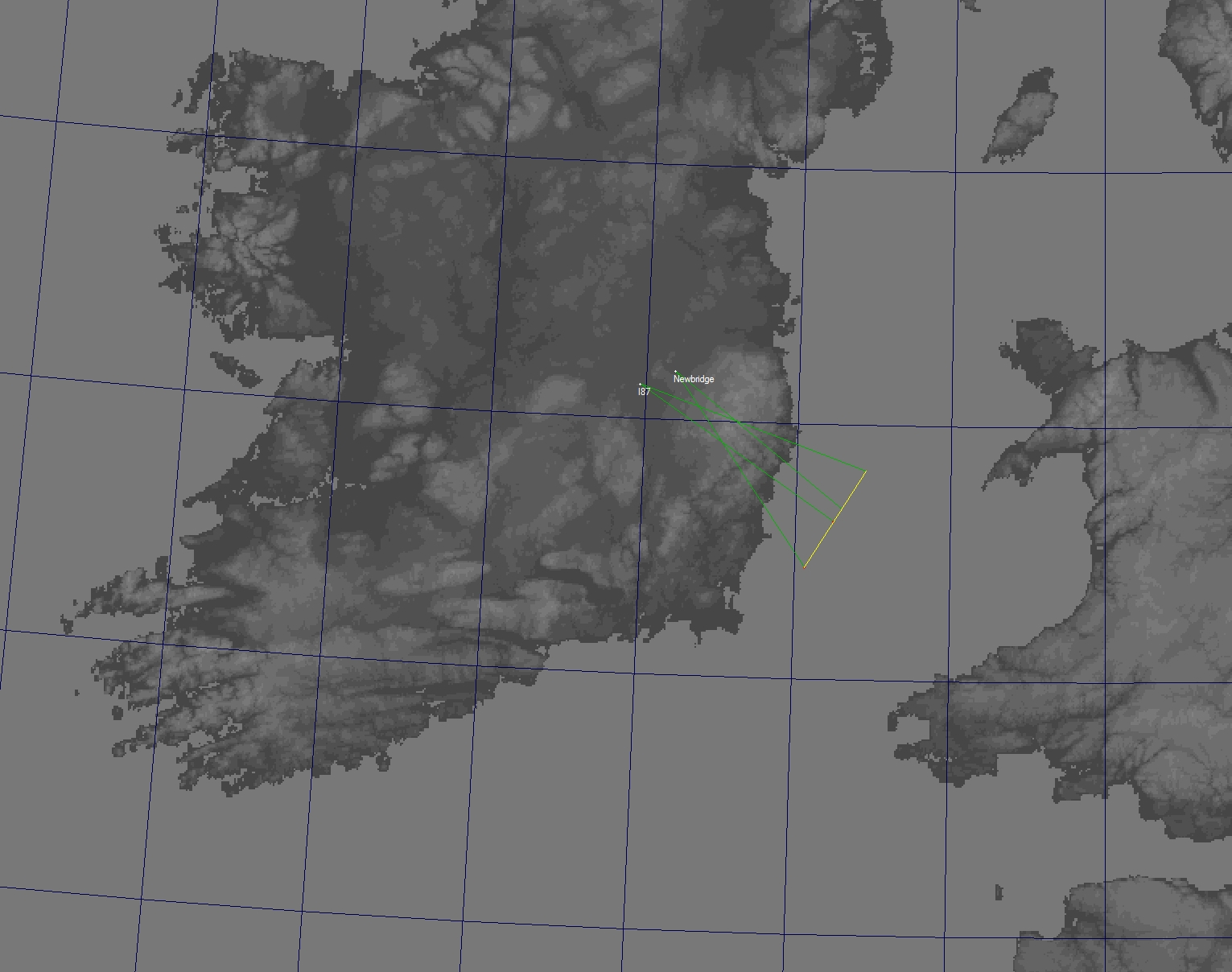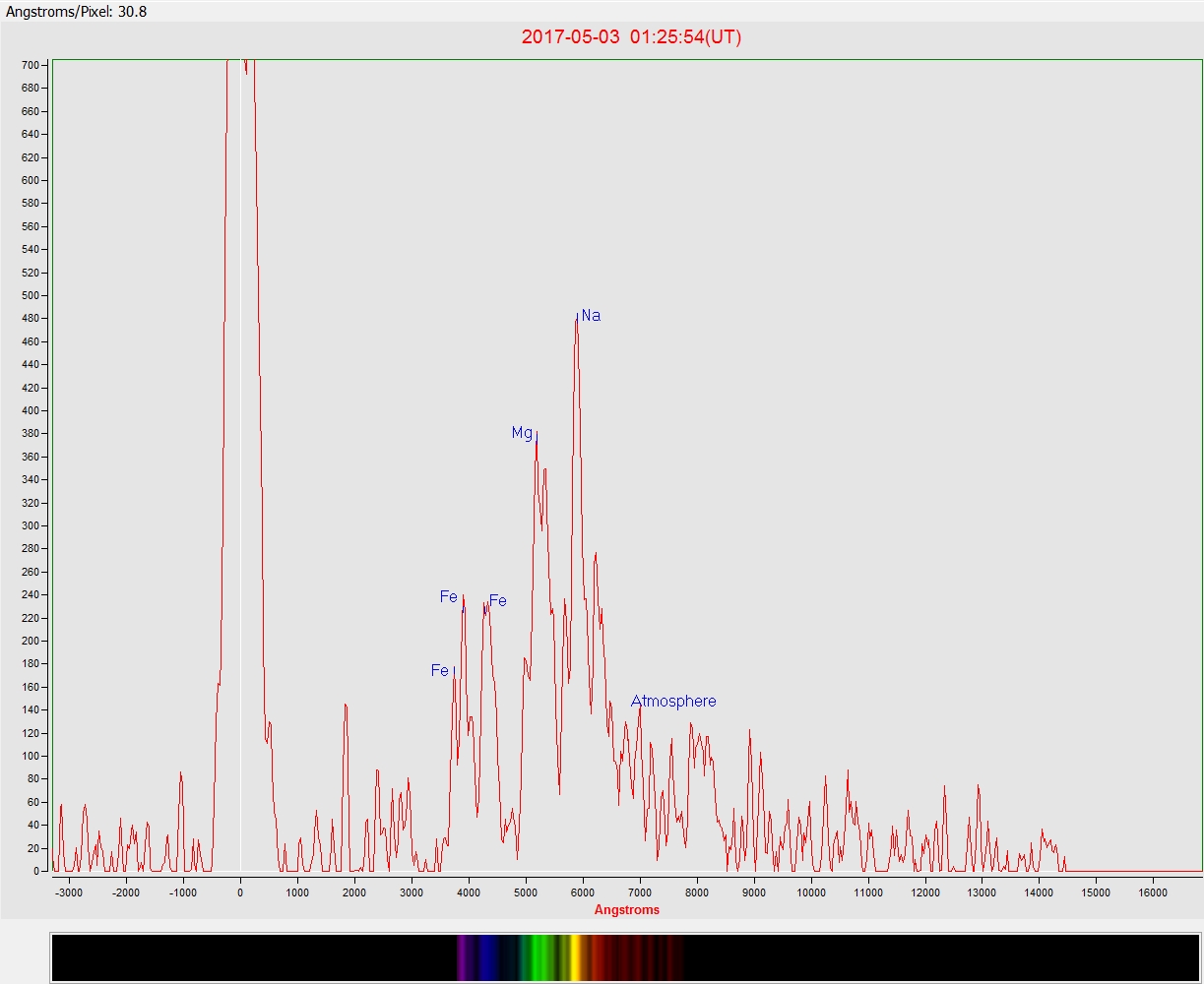- This topic has 6 replies, 3 voices, and was last updated 6 years, 9 months ago by
 Bill Ward.
Bill Ward.
-
AuthorPosts
-
5 May 2017 at 11:48 pm #573743
 Michael O’ConnellParticipant
Michael O’ConnellParticipantSporadic meter recorded over the Irish Sea on the 3rd May 2017 01:25UT.
Captured with Watec 902H Supreme camera, 6mm f0.75 lens and simple 500 L/mm grating
Contrast is a little poor so will try and tweak the camera settings in future.
See the following attachments:
* Ground Map,
* Orbit derived from UFOOrbit with additional data from Gordon Reineke (NEMETODE) (albeit based on Q0 quality level so to be treated with caution)
* Attempt at Spectrum – I didn’t have a calibration reference, so assumed the peak signal was Na – open to corrections on this.
Regards,
Michael.
7 May 2017 at 2:18 pm #578192 Andy WilsonKeymaster
Andy WilsonKeymasterHi Michael,
That is a very thorough analysis! Hopefully Bill or someone with knowledge of meteor spectroscopy will comment on your spectrum. It certainly looks good but I cannot comment on the line identification.
Cheers,
Andy
7 May 2017 at 9:17 pm #578193 Bill WardParticipant
Bill WardParticipantHi,
That’s a good catch, However from my own experience working with low res spectra is always a bit tricky.
One of the things that interests me is developing what I called “comparative spectroscopy” in the Astonomy Now article, and this turns out to be an excellent example. Although relatively low res there are definite features in this example but strangely it’s not whats there it’s whats NOT there!
Firstly it is relatively slow moving, then there is a clear “gap” in the spectrum in the blue green part and finally there are no, usually very prominent, atmospheric lines in the near IR.
Take a look at this. https://www.youtube.com/watch?v=1pfwYQ_dM1E
(I wouldn’t trust the graph, the actual lines are OK but the instrument correction was highly experimental…)
Slow moving, with a gap in the blue/green and no near IR lines. So now we can start to see these may be related, they are definitely made of the same stuff and behave in the same way, ablation wise. With only one example and no clear shower association then it looked like a sporadic but with more examples then maybe it/they are not. THEN your into looking for parent bodies and new showers and that’s when it gets really interesting!
It’s a potentially a powerful tool but unlike nice neat orbital elements spectroscopic reduction is a lot more subtle!
cheers,
Bill.
8 May 2017 at 11:22 pm #578196 Michael O’ConnellParticipant
Michael O’ConnellParticipantThanks guys.
Re the resolution issue, what focal length lens would you recommend?
9 May 2017 at 12:11 am #578197 Bill WardParticipant
Bill WardParticipantTHAT is the toughest question of them all!!! It’s ALL a compromise. All of my spectro systems are 12mm (and now a 16mm) to get a larger image scale but that does sacrifice a lot of sky with the narrow fov’s. I did a short test with a 3-8.5mm f1.0 lens set to ~7mm a while back and that gave a decent result spectroscopically so I’m planning on running that a bit longer after the summer when the sky gets darker again. There’s also the limiting mag issue, that’s another set of problems…
I’m tempted to say 12mm is the best just from experience but there are a lot of variables! No easy answer I’m afraid.
Cheers,
Bill.
9 May 2017 at 6:50 am #578198 Michael O’ConnellParticipant
Michael O’ConnellParticipantThanks Bill.
Im currently using a 500 Lines/mm grating. If I were to use say a 1,000 Lines/mm grating, would that help the spectrum resolution and compensation for the shorter focal length lens?
29 June 2017 at 8:24 pm #578323 Bill WardParticipant
Bill WardParticipantAppologies for the delay, been a bit busy last week…
The answer is yes and no, yet again. Yes the greater line count will give you greater dispersion and a “bigger” spectrum.
But due to the higher dispersion there is a magnitude penalty incurred. That is, you’d need a brighter meteor to exploit the gain and as there are fewer brighter meteors than faint it starts to play against you.
Also the shorter focal length lenses tend to have more field curvature and vignetting so there are some geometric issues that would need to be contended with should you capture a meteor.
However the bottom line is use what you have, I have captured spectra on a variety camera/lens/grating combinations. It’s just a matter of patience.
cheers,
Bill.
-
AuthorPosts
- You must be logged in to reply to this topic.



